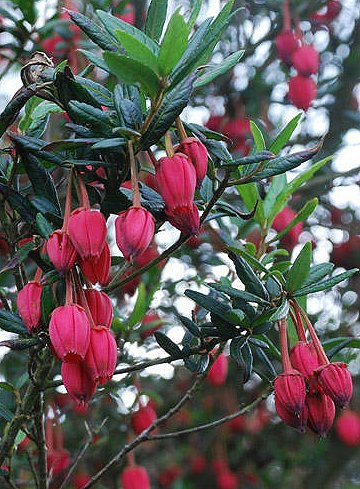
|
|
Chilean
Lantern Tree (Crinodendron hookerianum)
|
Chilean Lantern Tree
- Crinodendron hookerianum
Crinodendron hookerianum known as Chilean Lantern Tree is an evergreen tree endemic to Chile in the Elaeocarpaceae
family, it grows from Cautin to Palena (38 to 43°S). It occurs near streams or very humid sites or highly shady
places.
Introduced to UK by William Lobb in 1848 from Chile. The
name Crinodendron is Greek: beautiful flowers’ tree and hookerianum in honor of William Jackson
Hooker, English botanist who studied many Chilean plants
It is a shrub or small tree that measures up to 8 metres (26 ft) tall and 30 centimetres (12
in) in diameter, ash color. The leaves are alternate, with toothed edge and lanceolate shaped with acute
apex, petiolate 4–7 cm long and 0.7-1.8 wide, dark green above and hairy whitish green
below.
The flowers are hermaphrodite, solitary and
axillary, pinkish to red. Pedicels about 3–6 cm long, the calyx is formed by 5 fused sepals green
colored, the bell-shaped Corolla made up by 5 free petals which end in 3 teeth, 15-18
stamen,
with the style longer than the stamen. The Chilean Lantern Tree is an evergreen which produces
long, stalked buds in the autumn/fall. But it is not until the following spring that they swell up and form these 3cm long
flowers, looking a bit like tulips hanging upside down.
They appear from mid-spring to late-summer. The fruit is an inedible capsule with 3 to 5 valves
that splits open when ripe. The seeds are roundish.
A temperate climate plant and acid-lover performs best under somewhat acidic soil conditions
like other plants that hale from this part of South America. Lantern tree likes
moist, but well-drained acidic soil and is tolerant of a semi-shade exposure. It has no disease or pest problems and requires no
pruning.
What limitation there may be is simply that it is
half-hardy. In the UK it is better suited to southern England and Wales, while
it has been planted as far north as Scotland. In the US it best suited to moderate coastal
areas. It does well also in temperate Australia and New Zealand.
It can be appreciated year-round as well as serving as a useful hedge or
screen. Another asset is its size. It will slowly reach 25 feet after many
years, which is convenient as it's not likely to overwhelm any adjacent structures or reach up into power
lines. And its eventual spread is only 15 feet making it a good fit for modern
gardens. But it's most impressive asset is the nodding, urn-like (or lantern
shaped) flowers. They're small, and delicate and are a striking rose-crimson that contrasts beautifully with the dark green
foliage. Its beautiful flowers make it a highly valued ornamental tree.
Source:
http://en.wikipedia.org/wiki/Crinodendron_hookerianum
http://www.atreeaday.com/atreeaday/Crinodendron_hookerianum.html
http://www.rampantscotland.com/visit/glendoick06.htm
http://www.portmeirion-village.com/content.php?nID=110;lID=1
